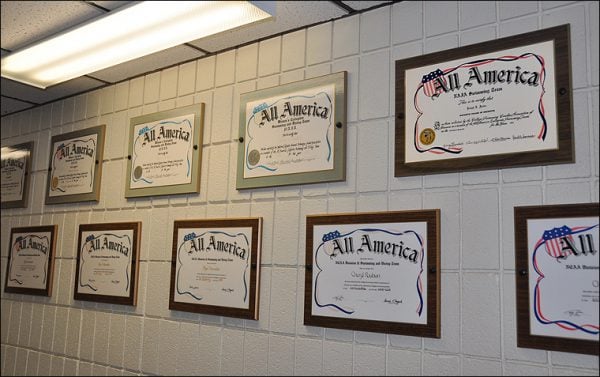We recently came across some excellent examples of the significant threat caused by light damage. We’re sharing some of the photos we took of this light damage in the hope of preventing it from affecting your framed artwork, photographs, and collections.

If the light damage affecting these All America certificates wasn’t enough, we also came across this recently:

Light damage is real and it’s not reversible. But it can be avoided!

Preventing Light Damage: Causes & Solutions
The majority of light damage is caused by ultraviolet (UV) light.
UV light is present in sunlight (this is the cause of sun-damaged curtains and upholstery fabrics), and in florescent light.
Yet preventing this sort of damage is a relatively simple 2-step process.
Avoid Direct Ultraviolet and Fluorescent Lighting

The first and easiest way to avoid UV light exposure is to keep your framed photographs, artwork or documents out of harm’s way by placing them on walls or shelves where they will not be exposed to sunlight through windows or skylights, or to overhead florescent lighting.
Use UV-Filtering Glass or Acrylic Glazing

Even if you are diligent about “avoiding the source,” it’s often a good idea to also use “filtration.”
While there are a number sleeves and diffusers that will filter UV light emitted by florescent bulbs, these are generally cumbersome and expensive. As an alternative, using a UV-filtering glazing such as Optix UV-Filtering Acrylic instead of glass will protect framed works by filtering out 98% of UV light.

Optix UV-Filtering Acrylic is available in precut sheets in many standard sizes, from 8 x 10″ up to 30 x 40″, and is perfect for protecting both vintage and contemporary artwork and artifacts from light damage.
If you don’t see the size you need you can order the next size up and we’ll cut the sheet down at no extra charge. During check out you can specify that you want board, paper, or acrylic sheets cut to a custom size under Special Instructions in the Payment section.

Optix UV-Filtering Acrylic is also included in all of the various easy-to-assemble Gallery 12 Wood Frames available from Archival Methods.
Recap & Other Resources
In closing, perhaps the best way to prevent light damage is to store your artwork, photographs and other such materials in a cool / dry / dark area or closet in your “living space” (i.e. not in your attic or basement) in appropriately-sized archival enclosures and boxes.
But if you want to display some of your materials, always use acid-free mats and the right picture frames. Avoid direct sunlight and exposure to florescent lighting. And consider using a UV-filtering glazing such as Optix UV-Filtering Acrylic.
Lastly, read a short summary on light damage from the Library of Congress.


